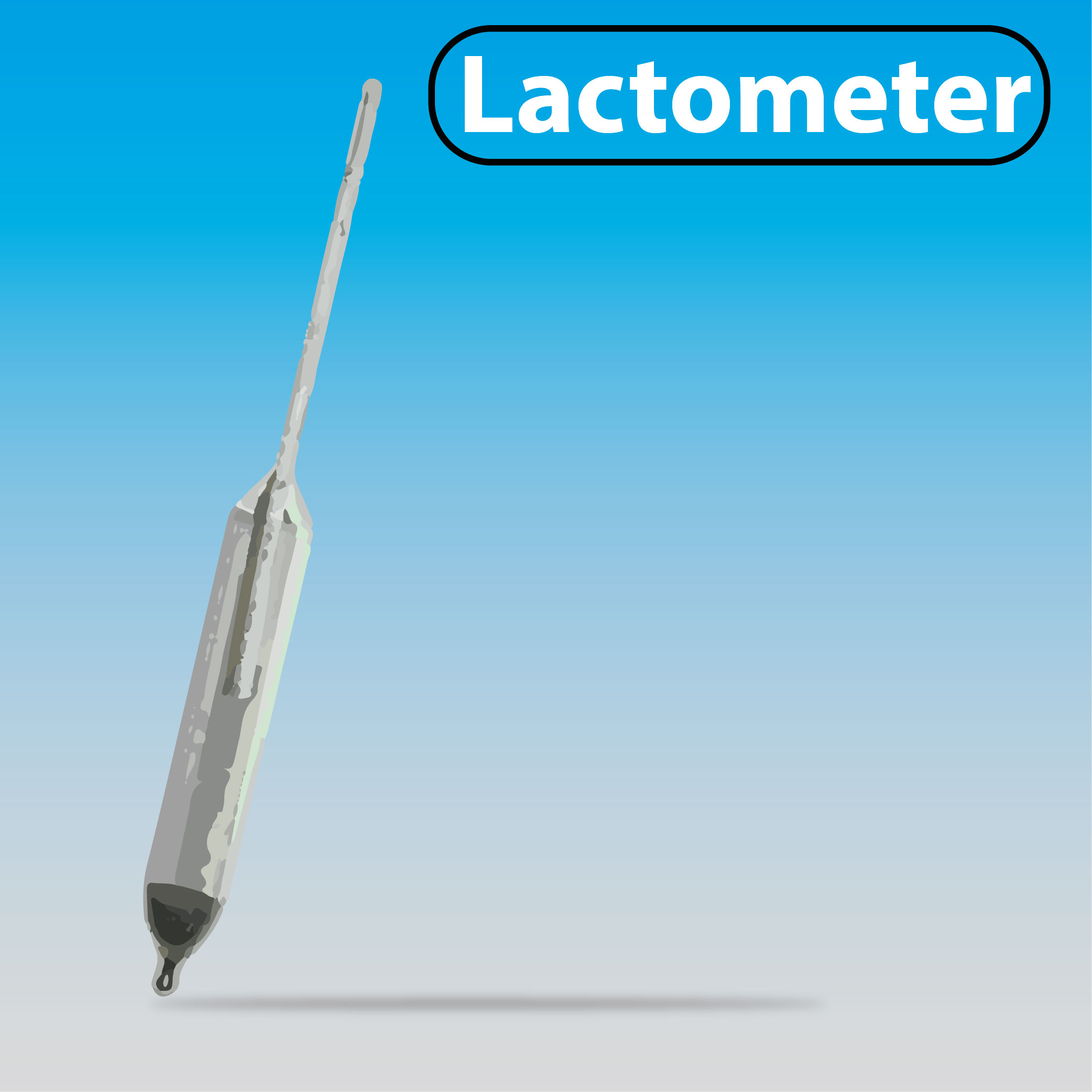
What is a lactometer used for?
Answer
572.1k+ views
Hint: It is an instrument that is commonly used in dairy farms and milk industries. It is used to test the purity of the milk which is produced by the cattle and is used to find the percentage of other components in the milk.
Complete answer:
A lactometer is used to check the purity of cow's milk, it’s a cylindrical vessel made by a blowing glass tube one side of the bulb is filled by mercury and the other side is a thin tube with scale. The specific gravity of milk doesn’t account for its configuration as milk contains a variety of elements that are either heavier or lighter than water. Additional tests for fat content are compulsory to determine the overall composition. It works on Archimedes Principle. It measures the relative density of milk with respect to water. For testing lactometer is dipped in the milk sample, the point up to which it sinks is marked, after that it is dipped in the water and the point is again marked, it sinks less in milk than water as we know that milk is denser than water and hence we can calculate the specific gravity of the sample. If the specific gravity of the sample is within the appropriate ranges, the milk is pure. If it is not, then there is some adulteration.
The specific gravity of milk is 1.028-1.032 kg/liter. Milk is a rich source of calcium, potassium, vitamin D, and vitamin B12. Higher milk consumption can increase the risk of prostate cancer. According to the Archimedes Principle, the apparent loss in the weight of any floating object is equal to the weight of the fluid displaced by it. Milk consists of protein casein which is 82% of the total milk protein rest 18% is serum or whey protein. Renin is the proteolytic enzyme found in the gastric juice of infants which helps in the digestion of the milk protein casein. Renin is an activated form of its precursor called prorenin; it is converted into renin with the help of hydrochloric acid. Renin accounts for the conversion of casein to paracasein which forms a complex with calcium called calcium paracaseinate which later is converted into peptones with the help of pepsin.

Note: Vitamin D is also known as calciferol, and vita B12 is also called cobalamin. Vitamin B12 deficiency may lead to a reduction in the number of red blood cells (anemia). The enzyme renin is also known as angiotensinogen and helps in blood pressure regulation.
Complete answer:
A lactometer is used to check the purity of cow's milk, it’s a cylindrical vessel made by a blowing glass tube one side of the bulb is filled by mercury and the other side is a thin tube with scale. The specific gravity of milk doesn’t account for its configuration as milk contains a variety of elements that are either heavier or lighter than water. Additional tests for fat content are compulsory to determine the overall composition. It works on Archimedes Principle. It measures the relative density of milk with respect to water. For testing lactometer is dipped in the milk sample, the point up to which it sinks is marked, after that it is dipped in the water and the point is again marked, it sinks less in milk than water as we know that milk is denser than water and hence we can calculate the specific gravity of the sample. If the specific gravity of the sample is within the appropriate ranges, the milk is pure. If it is not, then there is some adulteration.
The specific gravity of milk is 1.028-1.032 kg/liter. Milk is a rich source of calcium, potassium, vitamin D, and vitamin B12. Higher milk consumption can increase the risk of prostate cancer. According to the Archimedes Principle, the apparent loss in the weight of any floating object is equal to the weight of the fluid displaced by it. Milk consists of protein casein which is 82% of the total milk protein rest 18% is serum or whey protein. Renin is the proteolytic enzyme found in the gastric juice of infants which helps in the digestion of the milk protein casein. Renin is an activated form of its precursor called prorenin; it is converted into renin with the help of hydrochloric acid. Renin accounts for the conversion of casein to paracasein which forms a complex with calcium called calcium paracaseinate which later is converted into peptones with the help of pepsin.

Note: Vitamin D is also known as calciferol, and vita B12 is also called cobalamin. Vitamin B12 deficiency may lead to a reduction in the number of red blood cells (anemia). The enzyme renin is also known as angiotensinogen and helps in blood pressure regulation.
Recently Updated Pages
Master Class 12 Business Studies: Engaging Questions & Answers for Success

Master Class 12 Economics: Engaging Questions & Answers for Success

Master Class 12 English: Engaging Questions & Answers for Success

Master Class 12 Maths: Engaging Questions & Answers for Success

Master Class 12 Social Science: Engaging Questions & Answers for Success

Master Class 12 Chemistry: Engaging Questions & Answers for Success

Trending doubts
What is meant by exothermic and endothermic reactions class 11 chemistry CBSE

Which animal has three hearts class 11 biology CBSE

10 examples of friction in our daily life

One Metric ton is equal to kg A 10000 B 1000 C 100 class 11 physics CBSE

1 Quintal is equal to a 110 kg b 10 kg c 100kg d 1000 class 11 physics CBSE

Difference Between Prokaryotic Cells and Eukaryotic Cells




